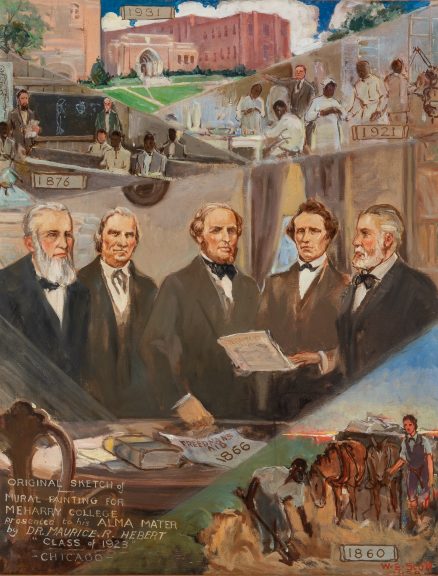Study for History of Meharry Medical College
, 1938Oil on canvas laid down on paperboard, 265/8 by 205/8 inches (sight)
- Zoom in on Artwork
- Print Page
- Email Page to Friend
This work is William Edouard Scott’s polished study for a mural painting offering a composite visual history of Meharry Medical College, in Nashville, Tennessee. The central image is a group portrait of the Meharry brothers, whose modest bequest to the Methodist Church established a school “for the training of Negro youth in medicine” in 1876. The five white men stand before a desk bearing a document that references the Freedman’s Aid Society, founded during the Civil War to create schools for formerly enslaved people, and the year 1866, when Congress passed the Fourteenth Amendment granting them citizenship. Progressing from the bottom to the top of the composition are other vignettes of the institution’s history. At the lower right Scott shows the incident that inspired the Meharrys’ gift, when a poor Black family risked their liberty to aid the young Samuel Meharry, an Ohio farmer then traveling through Kentucky. At the upper left, the school’s founding president, a Northerner, and first professor, a Southerner, together instruct the first students; above, Dr. John James Mullowney lectures to a class in 1921, the year he assumed the presidency of Meharry; and crowning the composition is a view of Meharry’s new building complex in North Nashville, completed in 1931. In interpreting Meharry’s history as an unbroken narrative of white, male leadership, with African Americans as passive generic recipients of their benevolent guidance, Scott closely followed Mullowney’s telling of Meharry’s history.i
The mural, which stands more than seven feet tall, remains at Meharry Medical College, for which it was painted in 1938 on the occasion of Mullowney’s retirement after seventeen years as president. In his autobiography, published in 1940, Mullowney claimed credit for the idea of celebrating the school’s history in an oil painting to be displayed in the lobby of the 1931 building. The selection of Scott for this commission, however, might have come from its donor, a Chicagoan. The inscription at the lower left corner of the study identifies him as Dr. Maurice E. Hebert, a 1923 graduate of Meharry. The first Black periodontist in the Chicago area, Hebert perhaps knew Scott by reputation if not personally and may have recommended him for the commission. This study was likely made to send to Meharry for the institution’s—that is, Mullowney’s—approval before Scott began work on the mural itself.
By the 1930s, Scott’s reputation for mural paintings in particular was at its height. Early in his career he had made such works for schools and other institutions—settings that favored idealized historical imagery and encouraged a straightforward, accessible style. Later, Scott painted murals across the US, including for Chicago’s 1933 Century of Progress Exposition and under the sponsorship of the WPA. He was a natural choice for a celebratory official portrayal of Meharry’s history. Legible and accessible, this mural combines a naturalism grounded in Scott’s academic training with a modernist approach to composition in the use of striking diagonals to separate the various scenes that map out Meharry’s history.
Wendy Greenhouse, PhD
Donated by M. Christine Schwartz to the Newberry Library, Chicago, Illinois, in 2021
i John J. Mullowney, typescript “A Pictorial History of Meharry Medical College,” May 1938, Meharry Medical College Archives, and Mullowney, American Gives a Chance (Tampa, FL: The Tribune Press, 1940), 90.
